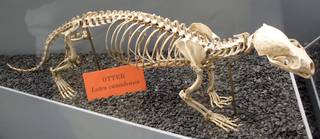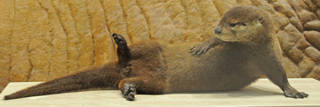WoRMS taxon details
Lontra canadensis Schreber, 1777
159017 (urn:lsid:marinespecies.org:taxname:159017)
accepted
Species
marine
Not documented
Distribution North America (Alaska west across northern Canada and the US to Nova Scotia)
Distribution North America (Alaska west across northern Canada and the US to Nova Scotia) [details]
WoRMS (2024). Lontra canadensis Schreber, 1777. Accessed at: https://www.marinespecies.org/aphia.php?p=taxdetails&id=159017 on 2024-09-24
![]() The webpage text is licensed under a Creative Commons Attribution 4.0 License
The webpage text is licensed under a Creative Commons Attribution 4.0 License
basis of record
Wilson, D. E.; Reeder, D. M. (1993). Mammal species of the world. <em>Smithsonian Institution Press.</em> , available online at http://vertebrates.si.edu/mammals/msw/ [details]
additional source Linkletter, L. E. (1977). A checklist of marine fauna and flora of the Bay of Fundy. <em>Huntsman Marine Laboratory, St. Andrews, N.B.</em> 68: p. [details]
additional source Animal Diversity Web. <em>University of Michigan Museum of Zoology.</em> , available online at http://animaldiversity.ummz.umich.edu/site/index.html [details]
ecology source Looby, A.; Erbe, C.; Bravo, S.; Cox, K.; Davies, H. L.; Di Iorio, L.; Jézéquel, Y.; Juanes, F.; Martin, C. W.; Mooney, T. A.; Radford, C.; Reynolds, L. K.; Rice, A. N.; Riera, A.; Rountree, R.; Spriel, B.; Stanley, J.; Vela, S.; Parsons, M. J. G. (2023). Global inventory of species categorized by known underwater sonifery. <em>Scientific Data.</em> 10(1). (look up in IMIS), available online at https://doi.org/10.1038/s41597-023-02745-4 [details]
additional source Linkletter, L. E. (1977). A checklist of marine fauna and flora of the Bay of Fundy. <em>Huntsman Marine Laboratory, St. Andrews, N.B.</em> 68: p. [details]
additional source Animal Diversity Web. <em>University of Michigan Museum of Zoology.</em> , available online at http://animaldiversity.ummz.umich.edu/site/index.html [details]
ecology source Looby, A.; Erbe, C.; Bravo, S.; Cox, K.; Davies, H. L.; Di Iorio, L.; Jézéquel, Y.; Juanes, F.; Martin, C. W.; Mooney, T. A.; Radford, C.; Reynolds, L. K.; Rice, A. N.; Riera, A.; Rountree, R.; Spriel, B.; Stanley, J.; Vela, S.; Parsons, M. J. G. (2023). Global inventory of species categorized by known underwater sonifery. <em>Scientific Data.</em> 10(1). (look up in IMIS), available online at https://doi.org/10.1038/s41597-023-02745-4 [details]
 Present
Present  Present in aphia/obis/gbif/idigbio
Present in aphia/obis/gbif/idigbio  Inaccurate
Inaccurate  Introduced: alien
Introduced: alien  Containing type locality
Containing type locality
From other sources
Diet Amphibians, fish, crayfish, and other invertebrates. Birds and small terrestrial mammals are also eaten on occation. [details]Dimensions Length: 66-107 cm (tail length is 32-46 cm); Weight: 3-14 kg [details]
Distribution North America (Alaska west across northern Canada and the US to Nova Scotia) [details]
Habitat Riparian zones, usually no more than a few hundred meters from water unless they are moving between rivers or lakes. River otters can tolerate a variety of environments including very cold and hot areas, high elevations, and coastal waters (rarely). [details]
Importance Hunted for many years for their attractive and durable fur. River otters also eat "trash fish" that compete with more economically beneficial game fish. [details]
Morphology Distinguishing characteristics: long streamlined animals with a thick tapered tail and short legs, wide, rounded head, small ears, and nostrils that can be closed underwater. long thick whiskers. they are dark brown to black above a ligther color ventrally. throat and cheeks are usually a golden. The feet have claws and are completely webbed. [details]
Predators None [details]
Reproduction Breeding: March to April. They have one to 5 young born 10-12 months later (delayed implantation of the fertilized egg in the uterus). Young are weaned 3-4 months and leave parents after a year. Sexual maturity is reached at 2-3 years of age. [details]
| Language | Name | |
|---|---|---|
| English | river otterNorth American river otter | [details] |
To Barcode of Life (7 barcodes)
To Biodiversity Heritage Library (35 publications)
To European Nucleotide Archive, ENA (Lontra canadensis)
To GenBank (75875 nucleotides; 48419 proteins)
To Global Biotic Interactions (GloBI)
To IUCN Red List (Least Concern)
To NMNH Extant Collection (Lontra canadensis)
To NMNH Extant Collection (USNM 589582 Lontra canadensis)
To ITIS
To Biodiversity Heritage Library (35 publications)
To European Nucleotide Archive, ENA (Lontra canadensis)
To GenBank (75875 nucleotides; 48419 proteins)
To Global Biotic Interactions (GloBI)
To IUCN Red List (Least Concern)
To NMNH Extant Collection (Lontra canadensis)
To NMNH Extant Collection (USNM 589582 Lontra canadensis)
To ITIS


